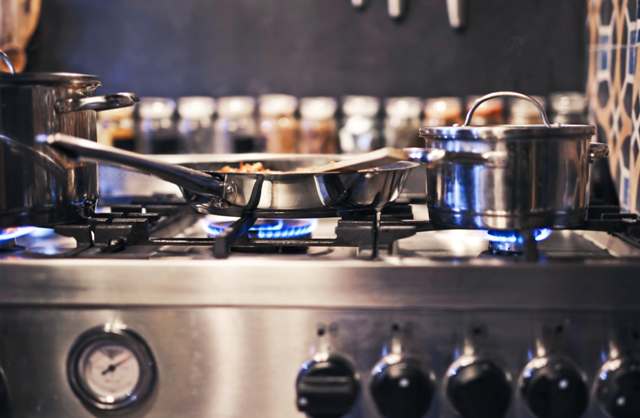Choosing between ceramic and stainless steel cookware can feel like selecting a superhero power—do you go for the flashy, eco-friendly, non-stick ceramic or the unyielding strength and durability of stainless steel? It’s like comparing apples and oranges, or in this case, pots and pans!
Let’s cook up some knowledge to find the pan that will be your kitchen sidekick!
Our Pick: Ceramic Cookware
After weighing the advantages and disadvantages, we’ve landed on ceramic as our top pick. There’s something about non-stick ceramic that feels like cooking magic, especially when you cook delicate foods like eggs, and they glide right off the pan. Plus, knowing that your food is touching a surface free of harmful chemicals gives you peace of mind. So, let’s explore the world of ceramic cookware together.
About Ceramic Cookware
Ceramic cookware is a game-changer for those who love cooking without much butter or oil. Pure ceramic cookware is made from natural clay, kiln-baked to high temperatures, resulting in a durable and non-stick surface. Ceramic-coated cookware, on the other hand, is metal (usually aluminum) coated with a non-stick ceramic layer. Whichever you choose, you’re in for a treat with its non-stick properties and colorful designs.

Features of Ceramic Cookware
Non-Stick Surface: Ceramic cookware features a natural non-stick surface, allowing for easy release of food and a breeze to clean.
Health-Conscious Cooking: With a non-stick ceramic, you can reduce the amount of cooking oils needed, making meals healthier.
Even Heat Distribution: High-quality cookware made from ceramic is known for its ability to heat evenly, which helps prevent cold spots and ensures your food cooks perfectly every time.
Stylish Aesthetics: Ceramic pots and pans often come in various colors and styles, making them not just cookware but a part of your kitchen décor.
Pros
- Non-stick without the use of harmful chemicals, providing a safe cooking environment
- Requires less oil or fat, promoting healthier cooking techniques
- Easy to clean, often dishwasher safe for added convenience
- Attractive design options to complement kitchen aesthetics
- Excellent heat distribution for even cooking and no hot spots
Cons
- Less durable than other types of cookware like cast iron, prone to chipping or cracking.
- Can be less tolerant of high heat, limiting some cooking application.
- May lose non-stick properties over time if not properly maintained.
About Stainless Steel Cookware
Stainless steel cookware is a robust conductor of heat, making it a staple in kitchens worldwide. Unlike ceramic, stainless steel pots and pans can withstand high heat and even welcome a good scrubbing. As a material for cookware, it’s a mix of iron, nickel, and chromium, creating a rust-resistant and shiny surface. Plus, most stainless steel cookware contains an aluminum core encased in steel, which helps with heat distribution and prevents warping.

Features of Stainless Steel Cookware
Durable Material: Stainless steel is incredibly durable and resistant to rust, corrosion, and stains, making it a long-lasting addition to any kitchen.
Superior Heat Conductor: The aluminum core makes stainless steel cookware an excellent heat conductor, ensuring food cooks evenly.
High Heat Tolerance: Stainless steel can withstand high temperatures, allowing for various cooking techniques.
Non-Reactive Surface: Unlike other metals, stainless steel does not react with acidic or alkaline foods, so cooking anything in it is safe.
Pros
- Highly durable and resistant to scratches and dents.
- Can be an alternative to Teflon pans for those concerned about chemical exposure.
- Excellent at retaining heat for consistent cooking results.
- Non-reactive with foods, meaning no unwanted flavors.
- Generally dishwasher safe, making cleanup easy.
Cons
- Food can stick if not used with enough oil or fat.
- Can have hot spots if not constructed with an aluminum core.
Commonalities Between Ceramic and Stainless Steel Cookware
On the surface, ceramic and stainless steel cookware may seem worlds apart but share some important features for any cook to consider. Both can offer a non-stick surface when used properly—although it’s important to note that not all cookware is created equally. Let’s explore these commonalities further and see what makes them both contenders in the kitchen arena.
Versatility
Firstly, both types of cookware can be incredibly versatile and capable of handling a variety of dishes. Whether you’re searing steaks in stainless steel or sautéing vegetables on ceramic, both can get the job done with the right know-how. Another similarity is their aesthetic appeal; both ceramic and stainless steel offer sleek designs that can add a touch of elegance to any kitchen.
Easy to Clean
Furthermore, ceramic and stainless steel cookware are both relatively easy to clean. While ceramic often requires less scrubbing due to its non-stick properties, stainless steel is not far behind, especially when it’s dishwasher safe.
Free of Chemicals
Finally, both types of cookware are generally considered safe options, with ceramic being free of chemicals such as PTFE and PFOA and stainless steel being non-reactive and free from coating that could decompose at high heat.
While they each have individual strengths, both can be excellent choices depending on your cooking style and preferences. Whether you value ease of cleaning, health considerations, or durability, each has something to offer in the kitchen.
Head-to-Head Comparison: Ceramic vs. Stainless Steel
In the culinary showdown between ceramic and stainless steel cookware, each brings its unique strengths to the kitchen table. The decision ultimately boils down to personal preference and cooking style. Whether you’re a fan of ceramic’s lightweight, non-stick convenience or the hardy, versatile nature of stainless steel, there’s a champion for every chef.
Health and Safety Considerations
When it comes to health and safety, ceramic cookware takes the lead with its non-stick surface that allows for cooking with less oil and its absence of harmful chemicals. Stainless steel is also a safe choice, as it doesn’t leach any metals into food and can handle high heat without releasing toxins. Both options provide health-conscious cooks with peace of mind, but stainless steel can cling to some foods, making release hard and messy.
It’s also important to consider how the materials react with food. Ceramic is naturally inert, making it a safe option for cooking acidic foods. At the same time, stainless steel’s non-reactive nature means it won’t pick up or impart any metallic taste, ensuring the true flavors of your dishes shine through.
Ease of Cleaning and Upkeep
Cleaning is a breeze with ceramic cookware, thanks to its non-stick surface. A quick wipe often suffices, and many options are dishwasher-safe. Stainless steel may require a bit more elbow grease, especially if food gets stuck, but its sturdy nature means you can scrub away without fear of damage. Both types will shine up nicely with proper care, ready for their next culinary adventure.
However, both types do require some attention to maintain their best qualities. Ceramic cookware should be handled carefully to avoid chipping the surface, while stainless steel may show water spots or require occasional polishing to keep its luster. Whichever you choose, taking the time to clean your ceramic cookware or to heat up and cool your stainless steel pieces properly will extend their lifespan and performance.
Durability and Performance Over Time
When it comes to durability, stainless steel cookware is almost unparalleled. Its resistance to rust, staining, and corrosion makes it a workhorse in the kitchen, capable of lasting for decades if properly maintained. Unlike ceramic cookware, stainless steel doesn’t chip or crack and is safe to use with metal utensils, enhancing its longevity. However, it’s worth noting that stainless steel doesn’t have a non-stick surface, which can affect its performance over time with certain foods.
While often praised for its non-stick properties, ceramic cookware can be less durable than stainless steel. The ceramic coating may degrade with constant use, especially if used at high temperatures or with metal utensils, which can scratch and eventually wear down the surface. To preserve performance, it’s vital to follow manufacturer guidelines for care and use, ensuring that your ceramic pieces maintain their non-stick qualities for as long as possible.
Versatility in the Kitchen
Stainless steel cookware shines in its ability to handle various cooking tasks. It’s well-suited for browning, searing, and sautéing at high temperatures. Furthermore, it can go from stovetop to oven without a hitch, making it ideal for recipes that require multiple cooking methods. On the other hand, it’s important to use medium heat to avoid burning foods, as stainless steel does not have non-stick properties. Additionally, it does not react with acidic ingredients, ensuring that flavors remain pure and uncontaminated.
Ceramic cookware is known for its excellent heat distribution, perfect for cooking at lower to medium heat. Its non-stick surface makes it a favorite for cooking delicate items like eggs or pancakes without the need for excess oil. However, its use is limited when it comes to high-heat methods such as searing. Also, some ceramic cookware may react with acidic foods over time, potentially impacting the flavor and color of your dishes.
Aesthetic and Design Implications
Regarding kitchen style, ceramic non-stick cookware often leads the pack. Available in various colors and designs, it can brighten up any kitchen space and add a touch of personality. Brands like Caraway cookware have capitalized on this trend, offering sets that are as much a statement piece as functional tools. The sleek, smooth surface of ceramic cookware is also visually appealing and can double as serveware for a seamless transition from stove to table.
With its classic and timeless appeal, stainless steel cookware is a staple in both professional and home kitchens for its sleek and functional design. The mirror finish of stainless steel is not only attractive but also practical, hiding wear and tear better than other materials. While not as colorful as ceramic options, stainless steel’s professional look is incredibly versatile and complements any kitchen décor.
Expert Tips for Optimizing Cookware Usage
Tips for Stainless Steel Cookware
- Use hot water and dish soap for regular cleaning; for tougher stains, a paste made from baking soda and water can be effective.
- Remember that not all stainless steel cookware is created equally—look for high-quality options with multiple layers or cores for the best heat distribution and durability.
Tips for Maintaining Ceramic Pieces
- To maintain the integrity of the ceramic coating, hand wash your cookware with mild dish soap and avoid harsh scrubbing.
- Let ceramic cookware cool before placing the pan into the sink to prevent thermal shock.
- For cleaning, use a soft sponge or cloth to preserve the non-stick coating; aggressive scrubbing can damage the ceramic layer.
- Stick to silicone utensils over metal spatulas to prevent scratching, and enjoy the benefits of non-stick cooking without worry. These practices make using ceramic pieces incredibly convenient and help preserve their lifespan.
Conclusion
When it’s time to choose, consider your cooking style and kitchen needs. A stainless steel cookware set shines for its ability to go from stovetop to oven, offering unmatched versatility and durability, perfect for chefs who value a seamless transition in their cooking process. If you lean towards health-conscious cooking, ceramic’s non-reactive cooking surfaces free of PFOA and PTFE may be your go-to, especially if you adore the charm of bohemian kitchens.
Ultimately, the right cookware balances functionality with your personal culinary journey. Explore the differences between ceramic and stainless steel cookware at KitchenwareWorld.com to make an informed decision that complements your kitchen adventures.